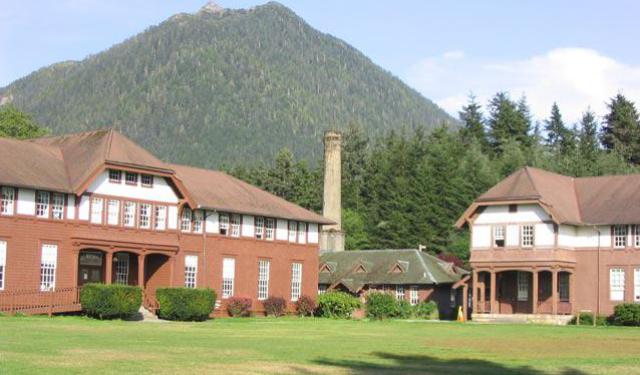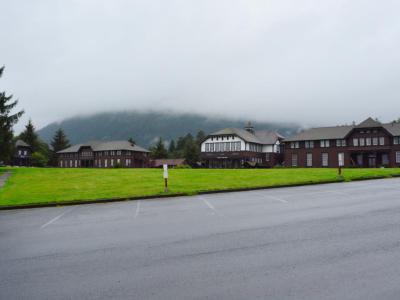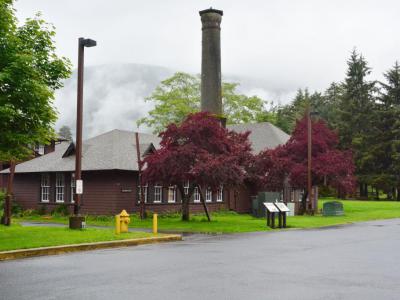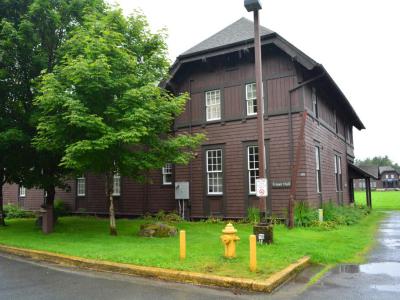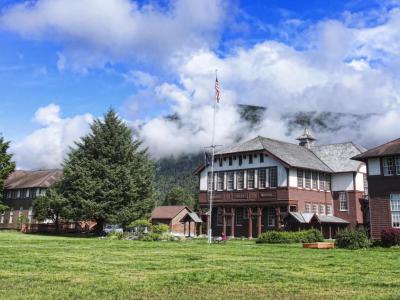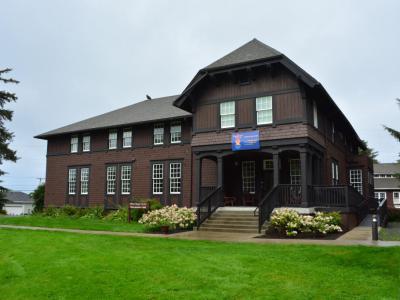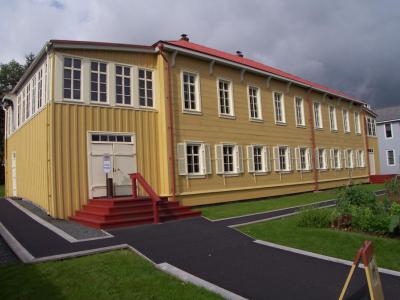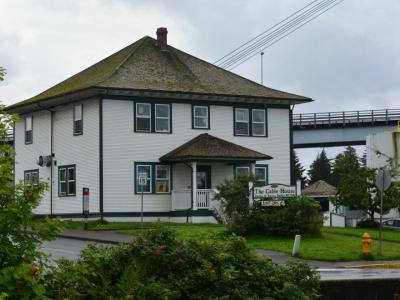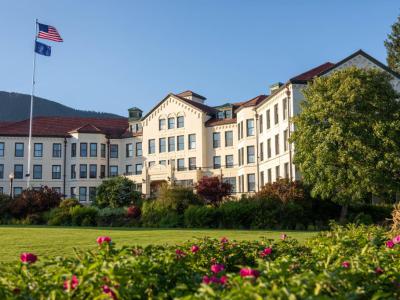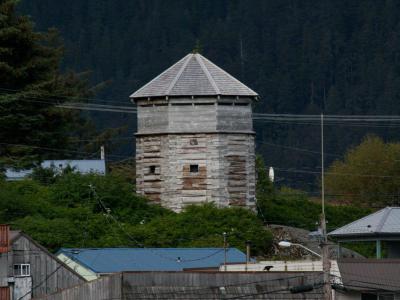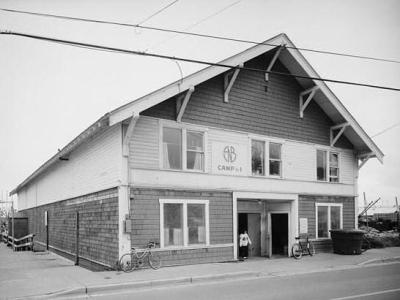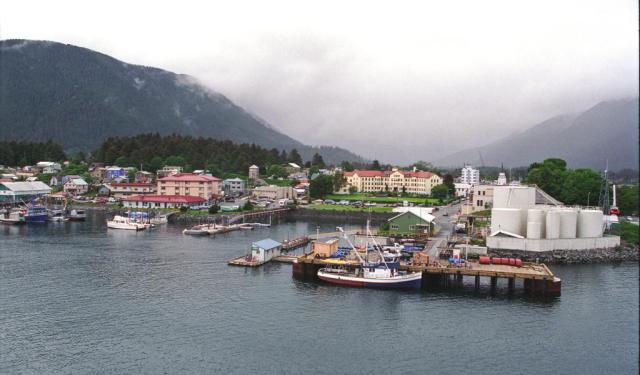Historical Buildings Walk (Self Guided), Sitka
The historical landmarks of Sitka serve as windows to pivotal moments in Alaska's past. From battlegrounds and fortresses to churches, schools, and military bases, these locations offer a fascinating peek into Sitka's varied and influential history, highlighting its significant contributions to both Alaskan and American narratives.
Among these sites is Sheldon Jackson College. Founded in 1878, it was the oldest institution of higher learning in Alaska, named after Reverend Sheldon Jackson, an early missionary and educational leader in the region.
The college campus is adorned with several notable structures, such as the Laundry Building, Fraser Hall, Richard H Allen Memorial Hall, and Stevenson Hall, each contributing to the architectural charm of the area.
One of Sitka's most iconic landmarks is the Russian Bishop's House, a testament to the city's Russian heritage. This meticulously preserved structure offers visitors a glimpse into Alaska's colonial past. Another tangible link to Sitka's strategic significance during the Russian-American period is the Russian Blockhouse.
Further ahead, the Cable House stands as a reminder of Sitka's importance as a hub for communication and trade during the late 19th century.
The Pioneer Home, originally a log barracks built by the Russians in the 1800s, is a tribute to the pioneering spirit of Alaska's early settlers. Later repurposed as an assisted living facility, it features beautifully manicured gardens and a gift shop showcasing crafts made by residents.
Meanwhile, the Alaska Native Brotherhood Hall symbolizes resilience and community among Alaska Native peoples, providing a space for cultural preservation and activism.
These historical buildings are focal points for cultural and educational experiences. For those interested in immersing themselves further in the city's heritage, our self-guided tour offers an opportunity to deepen their understanding of this unique corner of Alaska.
Among these sites is Sheldon Jackson College. Founded in 1878, it was the oldest institution of higher learning in Alaska, named after Reverend Sheldon Jackson, an early missionary and educational leader in the region.
The college campus is adorned with several notable structures, such as the Laundry Building, Fraser Hall, Richard H Allen Memorial Hall, and Stevenson Hall, each contributing to the architectural charm of the area.
One of Sitka's most iconic landmarks is the Russian Bishop's House, a testament to the city's Russian heritage. This meticulously preserved structure offers visitors a glimpse into Alaska's colonial past. Another tangible link to Sitka's strategic significance during the Russian-American period is the Russian Blockhouse.
Further ahead, the Cable House stands as a reminder of Sitka's importance as a hub for communication and trade during the late 19th century.
The Pioneer Home, originally a log barracks built by the Russians in the 1800s, is a tribute to the pioneering spirit of Alaska's early settlers. Later repurposed as an assisted living facility, it features beautifully manicured gardens and a gift shop showcasing crafts made by residents.
Meanwhile, the Alaska Native Brotherhood Hall symbolizes resilience and community among Alaska Native peoples, providing a space for cultural preservation and activism.
These historical buildings are focal points for cultural and educational experiences. For those interested in immersing themselves further in the city's heritage, our self-guided tour offers an opportunity to deepen their understanding of this unique corner of Alaska.
How it works: Download the app "GPSmyCity: Walks in 1K+ Cities" from Apple App Store or Google Play Store to your mobile phone or tablet. The app turns your mobile device into a personal tour guide and its built-in GPS navigation functions guide you from one tour stop to next. The app works offline, so no data plan is needed when traveling abroad.
Historical Buildings Walk Map
Guide Name: Historical Buildings Walk
Guide Location: USA » Sitka (See other walking tours in Sitka)
Guide Type: Self-guided Walking Tour (Sightseeing)
# of Attractions: 10
Tour Duration: 2 Hour(s)
Travel Distance: 2.3 Km or 1.4 Miles
Author: DanaOffice
Sight(s) Featured in This Guide:
Guide Location: USA » Sitka (See other walking tours in Sitka)
Guide Type: Self-guided Walking Tour (Sightseeing)
# of Attractions: 10
Tour Duration: 2 Hour(s)
Travel Distance: 2.3 Km or 1.4 Miles
Author: DanaOffice
Sight(s) Featured in This Guide:
- Sheldon Jackson College
- Laundry Building
- Fraser Hall
- Richard H. Allen Memorial Hall
- Stevenson Hall
- Russian Bishop's House
- The Cable House
- Pioneer Home
- Russian Blockhouse
- Alaska Native Brotherhood Hall
1) Sheldon Jackson College
Sheldon Jackson College (SJC) held a distinguished place as a small private institution of higher learning situated on Baranof Island in Sitka. Established in 1878, it stood as the oldest college in Alaska and maintained a significant historical connection with the Presbyterian Church. The college derived its name from Reverend Sheldon Jackson, a prominent missionary and educational pioneer in Alaska whose contributions left an indelible mark on the region's development. Throughout its history, SJC played a vital role in providing educational opportunities and fostering intellectual growth within the Sitka community and beyond.
However, faced with declining enrollment numbers, Sheldon Jackson College ceased its operations in 2007. Four years later, the campus ownership transitioned to the entity overseeing the Sitka Fine Arts Camp. Today, the former college campus serves as a hub for various educational, cultural, and artistic endeavors. It hosts a diverse array of organizations and institutions, including the Sheldon Jackson Museum, the Sitka Sound Science Center, the Sitka Summer Music Festival, the Sitka International Hostel, Outer Coast College, and numerous others.
However, faced with declining enrollment numbers, Sheldon Jackson College ceased its operations in 2007. Four years later, the campus ownership transitioned to the entity overseeing the Sitka Fine Arts Camp. Today, the former college campus serves as a hub for various educational, cultural, and artistic endeavors. It hosts a diverse array of organizations and institutions, including the Sheldon Jackson Museum, the Sitka Sound Science Center, the Sitka Summer Music Festival, the Sitka International Hostel, Outer Coast College, and numerous others.
2) Laundry Building
Like the other main campus buildings, the Laundry Building exhibits a cohesive Craftsman and Western Stick influence, blending eclectic elements of both styles with the rustic surroundings and the formal campus plan. Its design features protruding roof brackets, projecting balconies and porches, recessed entries, wood shingle siding, and accentuated vertical timbers, all characteristic of the Western Stick style. Originally painted or stained white, the buildings are now adorned in the distinctive "Sheldon Jackson brown," with white trim.
Constructed as an integral part of the campus infrastructure, the Laundry Building played a pivotal role in supporting the daily operations of the school and college since its establishment in the late 19th century. However, as the institution faced financial challenges over the years, many of its buildings, including the Laundry Building, fell into disrepair. By the time the Sitka Fine Arts Camp assumed control of the campus in 2011, the buildings were in urgent need of restoration, with leaking roofs, failing siding, and rotting windows.
In 2014, efforts were undertaken to preserve and stabilize the Laundry Building, including re-roofing to address structural issues. This restoration work not only ensured the structural integrity of the building but also contributed to the preservation of Sheldon Jackson School and College's architectural heritage.
Constructed as an integral part of the campus infrastructure, the Laundry Building played a pivotal role in supporting the daily operations of the school and college since its establishment in the late 19th century. However, as the institution faced financial challenges over the years, many of its buildings, including the Laundry Building, fell into disrepair. By the time the Sitka Fine Arts Camp assumed control of the campus in 2011, the buildings were in urgent need of restoration, with leaking roofs, failing siding, and rotting windows.
In 2014, efforts were undertaken to preserve and stabilize the Laundry Building, including re-roofing to address structural issues. This restoration work not only ensured the structural integrity of the building but also contributed to the preservation of Sheldon Jackson School and College's architectural heritage.
3) Fraser Hall
Fraser Hall, situated closest to the Sheldon Jackson Museum, stands as a historic cornerstone of the Sheldon Jackson School and College campus. Designed by the New York architecture firm Ludlow and Peabody and constructed in 1911, Fraser Hall is steeped in the rich heritage of the institution. Initially serving as a dormitory for younger boys, it was named in honor of Presbyterian missionary Thomas Fraser, reflecting the school's commitment to education and community service.
As part of the original campus quad, Fraser Hall exemplifies the architectural vision of Ludlow and Peabody, blending elements of classical design with practical functionality. Over the years, Fraser Hall has evolved to accommodate various functions, from housing administrative offices for Sheldon Jackson College to its current role as classroom space and dormitories for the Sitka Fine Arts Camp.
Its restoration in recent years has been a labor of love, undertaken to preserve its historic significance and architectural integrity. Preservation efforts have focused on addressing weather damage, particularly on the west- and south-facing sides, where wooden shingles required replacement, porch columns needed refacing, and hidden or removed details such as wooden trim and window casings were uncovered or replicated. These meticulous restoration efforts have revitalized Fraser Hall, ensuring that it continues to serve as a vibrant hub of education and artistic endeavor within the Sitka community.
As part of the original campus quad, Fraser Hall exemplifies the architectural vision of Ludlow and Peabody, blending elements of classical design with practical functionality. Over the years, Fraser Hall has evolved to accommodate various functions, from housing administrative offices for Sheldon Jackson College to its current role as classroom space and dormitories for the Sitka Fine Arts Camp.
Its restoration in recent years has been a labor of love, undertaken to preserve its historic significance and architectural integrity. Preservation efforts have focused on addressing weather damage, particularly on the west- and south-facing sides, where wooden shingles required replacement, porch columns needed refacing, and hidden or removed details such as wooden trim and window casings were uncovered or replicated. These meticulous restoration efforts have revitalized Fraser Hall, ensuring that it continues to serve as a vibrant hub of education and artistic endeavor within the Sitka community.
4) Richard H. Allen Memorial Hall
Constructed in 1910-11, Richard H. Allen Memorial Hall stands as the main building in the campus design, envisioned by the esteemed New York firm of Ludlow and Peabody. Serving a dual purpose as both a gymnasium and a classroom facility, the hall embodies the multifaceted mission of the institution, catering to religious, cultural, and social interests of both the school and the broader Sitka community. Its strategic position as the focal point of a quadrangle site plan underscores its significance as the heart of the campus, anchoring the educational and communal activities of the institution.
Over the years, Richard H. Allen Memorial Hall has played a pivotal role in shaping the educational experience of generations of students while contributing to the rich cultural fabric of Sitka. As a hub of physical education, intellectual discourse, and social interaction, the hall has witnessed countless moments of learning, growth, and camaraderie. Its architectural style, characterized by classical elements and timeless design, reflects the enduring values and aspirations of the institution and its founders.
In the late 1990s, recognizing the historical and architectural significance of Richard H. Allen Memorial Hall, local preservationists embarked on a concerted effort to secure grants for its restoration. This initiative underscored the community's commitment to preserving its cultural heritage and ensuring that the hall would continue to serve as a symbol of academic excellence and community pride for future generations.
Over the years, Richard H. Allen Memorial Hall has played a pivotal role in shaping the educational experience of generations of students while contributing to the rich cultural fabric of Sitka. As a hub of physical education, intellectual discourse, and social interaction, the hall has witnessed countless moments of learning, growth, and camaraderie. Its architectural style, characterized by classical elements and timeless design, reflects the enduring values and aspirations of the institution and its founders.
In the late 1990s, recognizing the historical and architectural significance of Richard H. Allen Memorial Hall, local preservationists embarked on a concerted effort to secure grants for its restoration. This initiative underscored the community's commitment to preserving its cultural heritage and ensuring that the hall would continue to serve as a symbol of academic excellence and community pride for future generations.
5) Stevenson Hall
Designed in 1910 by the esteemed New York architecture firm of Ludlow and Peabody, Stevenson Hall was constructed in 1911 as part of a comprehensive campus development plan. Its strategic location on the western edge of the campus quadrangle underscores its prominence within the educational landscape of Sitka and its pivotal role in shaping the academic and cultural experiences of students.
As one of the six buildings designed by Ludlow and Peabody, Stevenson Hall is a testament to the enduring legacy of Sheldon Jackson School and College as the oldest educational institution in Alaska. Recognized for its historical significance and its commitment to educating native Alaskans, the hall embodies the institution's mission of academic excellence and cultural enrichment. Through its timeless architectural design and its central position within the campus, Stevenson Hall continues to serve as a symbol of educational heritage and community pride, preserving the spirit of learning for generations to come.
As one of the six buildings designed by Ludlow and Peabody, Stevenson Hall is a testament to the enduring legacy of Sheldon Jackson School and College as the oldest educational institution in Alaska. Recognized for its historical significance and its commitment to educating native Alaskans, the hall embodies the institution's mission of academic excellence and cultural enrichment. Through its timeless architectural design and its central position within the campus, Stevenson Hall continues to serve as a symbol of educational heritage and community pride, preserving the spirit of learning for generations to come.
6) Russian Bishop's House (must see)
The Russian Bishop's House stands as a remarkable testament to the Russian colonial legacy in North America,. Constructed in 1842, this historic structure is one of the few remaining examples of Russian colonial architecture on the continent. Sitka, known as New Archangel during the Russian colonial era, served as the capital of Russian America, and the Bishop's House played a central role in the region's religious and administrative affairs.
During its heyday, the Bishop's House served as the hub of Russian Orthodox Church authority in a vast diocese that extended from California to Siberian Kamchatka. As a symbol of the Russian Orthodox Church's influence and presence in the region, the Bishop's House held significant religious and cultural importance for the local community. However, by the late 20th century, the once-proud structure had fallen into disrepair, with deteriorating walls, leaking roofs, and structural instability threatening its survival.
In 1973, for over 16 years, meticulous efforts were undertaken to restore the building to its original 1853 appearance, ensuring that future generations could experience and appreciate the rich history and heritage of Sitka's Russian-American period. Today, visitors to the restored Russian Bishop's House have the opportunity to step back in time and gain insight into daily life during the Russian colonial era, offering a glimpse into Sitka's fascinating past and cultural heritage.
During its heyday, the Bishop's House served as the hub of Russian Orthodox Church authority in a vast diocese that extended from California to Siberian Kamchatka. As a symbol of the Russian Orthodox Church's influence and presence in the region, the Bishop's House held significant religious and cultural importance for the local community. However, by the late 20th century, the once-proud structure had fallen into disrepair, with deteriorating walls, leaking roofs, and structural instability threatening its survival.
In 1973, for over 16 years, meticulous efforts were undertaken to restore the building to its original 1853 appearance, ensuring that future generations could experience and appreciate the rich history and heritage of Sitka's Russian-American period. Today, visitors to the restored Russian Bishop's House have the opportunity to step back in time and gain insight into daily life during the Russian colonial era, offering a glimpse into Sitka's fascinating past and cultural heritage.
7) The Cable House
The Cable House holds a significant place in history as the northern terminus of Alaska's pioneering telegraph connection to the contiguous United States. Constructed in 1908, this charming hip-roofed building played a pivotal role in the Washington-Alaska Military Cable and Telegraph System, which marked the advent of submarine telegraph cables in the region. Serving as a crucial communication link, this telegraph system was instrumental in connecting Alaska with the rest of the United States, strengthening the nation's presence in the region amidst border disputes with Canada.
Beyond its historical importance, The Cable House has adapted to modern times, now accommodating Sitka's public radio station on its upper floor and the ground-floor Beak Restaurant. Visitors to The Cable House can enjoy the picturesque views from the deck, offering a perfect vantage point for witnessing stunning sunsets over the Sitka landscape.
Additionally, the grounds surrounding The Cable House feature apple trees, contributing to Sitka's endeavors in promoting locally grown foods and fostering sustainability initiatives within the community. This convergence of history, modern amenities, and natural beauty makes The Cable House a noteworthy landmark in Sitka's cultural landscape.
Beyond its historical importance, The Cable House has adapted to modern times, now accommodating Sitka's public radio station on its upper floor and the ground-floor Beak Restaurant. Visitors to The Cable House can enjoy the picturesque views from the deck, offering a perfect vantage point for witnessing stunning sunsets over the Sitka landscape.
Additionally, the grounds surrounding The Cable House feature apple trees, contributing to Sitka's endeavors in promoting locally grown foods and fostering sustainability initiatives within the community. This convergence of history, modern amenities, and natural beauty makes The Cable House a noteworthy landmark in Sitka's cultural landscape.
8) Pioneer Home
Originally built as a log barracks by the Russians in the 1800s, the Sitka Pioneer Home has undergone significant transformations over the years. Initially serving as quarters for the U.S. Marines stationed in Sitka until 1892, the buildings stood idle after the base was closed in 1912.
In response to the growing need for a home to accommodate pioneers, prospectors, and others unable to care for themselves, the Alaska Pioneer Home was established in Sitka in 1913. Representative Arthur G. Shoup introduced a bill to appropriate funds for the home, utilizing the old barracks with permission from the Navy Department. Initially, only indigent men were admitted to the home.
As the years passed, the original buildings became dilapidated and costly to maintain. In response, Congress granted the former Naval Reserve to the Territory of Alaska, leading to the construction of the present concrete building in the 1930s. This new facility provided accommodation for 170 men, but there were no provisions for women until the 1949 Legislature funded a separate home for women. Subsequent additions, including the North Wing, expanded the capacity and improved the facilities of the Pioneer Home.
Today, the Sitka Pioneer Home serves as an assisted living facility, offering care for residents with Alzheimer's Disease and Related Dementia. Visitors can stroll through beautifully manicured gardens in front of the home and explore the gift shop, which features Alaska arts and crafts made by the residents.
In response to the growing need for a home to accommodate pioneers, prospectors, and others unable to care for themselves, the Alaska Pioneer Home was established in Sitka in 1913. Representative Arthur G. Shoup introduced a bill to appropriate funds for the home, utilizing the old barracks with permission from the Navy Department. Initially, only indigent men were admitted to the home.
As the years passed, the original buildings became dilapidated and costly to maintain. In response, Congress granted the former Naval Reserve to the Territory of Alaska, leading to the construction of the present concrete building in the 1930s. This new facility provided accommodation for 170 men, but there were no provisions for women until the 1949 Legislature funded a separate home for women. Subsequent additions, including the North Wing, expanded the capacity and improved the facilities of the Pioneer Home.
Today, the Sitka Pioneer Home serves as an assisted living facility, offering care for residents with Alzheimer's Disease and Related Dementia. Visitors can stroll through beautifully manicured gardens in front of the home and explore the gift shop, which features Alaska arts and crafts made by the residents.
9) Russian Blockhouse
Serving as a replica of the original walled fortifications that delineated Russia's control, the Russian Blockhouse offers visitors insight into the defensive structures that once guarded Novo-Archangelsk, present-day Sitka. Originally, the Russians erected a capital D-shaped five-sided blockhouse at this site, strategically positioned to overlook the gate between the Russian outpost and the neighboring Tlingit village. Additionally, an octagonal blockhouse and a small square blockhouse were strategically placed within the vicinity, each fulfilling specific defensive purposes.
Historical records indicate that the original blockhouses gradually fell into disrepair following significant events such as the transfer of Alaska from Russia to the United States in 1867. Over time, decay and neglect took their toll, leading to the dismantling of the D-shaped and octagonal blockhouses in 1899 and 1921, respectively.
However, recognizing the historical significance of these structures, civic-minded citizens, including the Alaska Native Brotherhood, undertook initiatives to preserve their legacy. Consequently, in 1962, a second octagonal reproduction blockhouse was constructed at the site of the Sitka National Monument, ensuring that future generations could appreciate and learn from this crucial aspect of Alaska's colonial history.
Historical records indicate that the original blockhouses gradually fell into disrepair following significant events such as the transfer of Alaska from Russia to the United States in 1867. Over time, decay and neglect took their toll, leading to the dismantling of the D-shaped and octagonal blockhouses in 1899 and 1921, respectively.
However, recognizing the historical significance of these structures, civic-minded citizens, including the Alaska Native Brotherhood, undertook initiatives to preserve their legacy. Consequently, in 1962, a second octagonal reproduction blockhouse was constructed at the site of the Sitka National Monument, ensuring that future generations could appreciate and learn from this crucial aspect of Alaska's colonial history.
10) Alaska Native Brotherhood Hall
The Alaska Native Brotherhood Hall, also known as Sitka Camp No. 1, holds significant historical importance as the original chapter of the Alaska Native Brotherhood, a statewide organization advocating for the rights and interests of Alaska Natives. Constructed in 1914, the two-story wooden building is situated on Katlian Street along the waterfront in Sitka, Alaska. Its architectural design features a wood-frame construction, measuring approximately 40 feet wide and 60 feet long, with a substantial portion extending over the water, supported by pilings.
Over the years, the Alaska Native Brotherhood Hall has undergone alterations and expansions, with evidence suggesting additions to the front quarter of the building and the raising of the roof to a full two stories. The interior of the hall primarily comprises a spacious two-story auditorium, with a stage positioned at the rear overlooking the water. A narrow gallery encircles the rear and side walls of the auditorium, accessible via internal stairs. Additionally, the front portion of the building accommodates a lobby area on the first floor and office space for the Brotherhood on the second floor.
Founded in Sitka in 1912 by Tlingit natives, the Alaska Native Brotherhood played a pivotal role in combating discrimination against Alaska Natives and advocating for their rights. Its efforts led to significant achievements, including securing United States citizenship for Alaska Natives and the passage of the Alaska Historic Preservation Act. Designated as a National Historic Landmark in 1987, the Alaska Native Brotherhood Hall stands as a testament to the enduring legacy of advocacy and community empowerment within the Alaska Native community.
Over the years, the Alaska Native Brotherhood Hall has undergone alterations and expansions, with evidence suggesting additions to the front quarter of the building and the raising of the roof to a full two stories. The interior of the hall primarily comprises a spacious two-story auditorium, with a stage positioned at the rear overlooking the water. A narrow gallery encircles the rear and side walls of the auditorium, accessible via internal stairs. Additionally, the front portion of the building accommodates a lobby area on the first floor and office space for the Brotherhood on the second floor.
Founded in Sitka in 1912 by Tlingit natives, the Alaska Native Brotherhood played a pivotal role in combating discrimination against Alaska Natives and advocating for their rights. Its efforts led to significant achievements, including securing United States citizenship for Alaska Natives and the passage of the Alaska Historic Preservation Act. Designated as a National Historic Landmark in 1987, the Alaska Native Brotherhood Hall stands as a testament to the enduring legacy of advocacy and community empowerment within the Alaska Native community.
Walking Tours in Sitka, Alaska
Create Your Own Walk in Sitka
Creating your own self-guided walk in Sitka is easy and fun. Choose the city attractions that you want to see and a walk route map will be created just for you. You can even set your hotel as the start point of the walk.
Sitka Introduction Walking Tour
Rubbing shoulders with the Tongass National Forest in Alaska, the coastal town of Sitka boasts a fascinating past, having served first as the capital of Russian America and then the Alaska Territory.
The name Sitka is derived from "Shee At'iká," which in the Tlingit language (of the indigenous people of Southeast Alaska and Western Canada) means"people on the outside of... view more
Tour Duration: 2 Hour(s)
Travel Distance: 2.0 Km or 1.2 Miles
The name Sitka is derived from "Shee At'iká," which in the Tlingit language (of the indigenous people of Southeast Alaska and Western Canada) means"people on the outside of... view more
Tour Duration: 2 Hour(s)
Travel Distance: 2.0 Km or 1.2 Miles
The Most Popular Cities
/ view all
